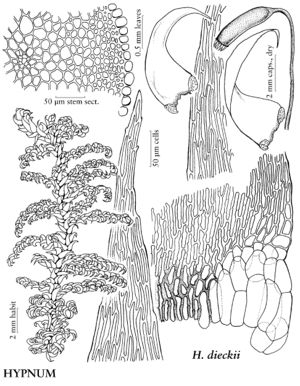Difference between revisions of "Hypnum dieckei"
Bot. Centralbl. 44: 423. 1890.
FNA>Volume Importer |
imported>Volume Importer |
||
| (5 intermediate revisions by 2 users not shown) | |||
| Line 9: | Line 9: | ||
|special_status={{Treatment/ID/Special_status | |special_status={{Treatment/ID/Special_status | ||
|code=F | |code=F | ||
| − | |label= | + | |label=Illustrated |
}} | }} | ||
|basionyms= | |basionyms= | ||
| Line 15: | Line 15: | ||
|name=Stereodon dieckei | |name=Stereodon dieckei | ||
|authority=(Renauld & Cardot) Brotherus | |authority=(Renauld & Cardot) Brotherus | ||
| + | |rank=species | ||
}} | }} | ||
|hierarchy=Hypnaceae;Hypnum;Hypnum dieckei | |hierarchy=Hypnaceae;Hypnum;Hypnum dieckei | ||
| Line 39: | Line 40: | ||
-->{{#Taxon: | -->{{#Taxon: | ||
name=Hypnum dieckei | name=Hypnum dieckei | ||
| − | |||
|authority=Renauld & Cardot | |authority=Renauld & Cardot | ||
|rank=species | |rank=species | ||
| Line 53: | Line 53: | ||
|publication title=Bot. Centralbl. | |publication title=Bot. Centralbl. | ||
|publication year=1890 | |publication year=1890 | ||
| − | |special status= | + | |special status=Illustrated |
| − | |source xml=https:// | + | |source xml=https://bitbucket.org/aafc-mbb/fna-data-curation/src/2e0870ddd59836b60bcf96646a41e87ea5a5943a/coarse_grained_fna_xml/V28/V28_837.xml |
|genus=Hypnum | |genus=Hypnum | ||
|species=Hypnum dieckei | |species=Hypnum dieckei | ||
Latest revision as of 21:38, 5 November 2020
Plants medium-sized, dark green to golden green or nearly black. Stems 4–8 cm, red-brown to nearly black, procumbent to suberect, usually regularly pinnate, branches 0.2–1.5 cm; hyalodermis present, central strand poorly differentiated; pseudoparaphyllia foliose, broad. Stem leaves falcate, curved downward toward substrate, ovate-lanceolate, curving slightly to insertion, tapering to apex, 1–1.5 × 0.4–0.5 mm; base weakly decurrent; margins plane, entire to sinuate proximally, often sharply serrate toward apex; acumen narrow; costa usually indistinct; alar cells rectangular, abruptly enlarged, region well defined, 2 or 3 cells high, 3 or 4 cells wide, outermost cells with thinner walls; basal laminal cells shorter, wider than medial cells, yellowish to brownish, especially adjacent to hyaline alar cells, walls porose; medial cells 40–60 × 3–4 µm. Sexual condition dioicous; inner perichaetial leaves lanceolate, margins toothed, apex finely pointed, costa obscure. Seta red-brown when mature, 2–4.5 cm. Capsule nodding when mature, red-brown, cylindric, 3–4.5 mm; annulus 1- or 2-seriate; operculum conic; endostome cilia rudimentary.
Phenology: Capsules mature Jun–Jul.
Habitat: Terrestrial, rock, logs, near water courses, seepage areas, open to somewhat shaded areas, usually where persistent moisture is available
Elevation: low to moderate elevations (0-1500 m)
Distribution

B.C., Alaska, Calif., Oreg., Wash., e Asia.
Discussion
Hypnum dieckei is distributed around the north Pacific and can be frequent on logs or outcrops near streams. The plants are distinctive especially in summer when sporophytes are produced, because H. dieckei is the only North American species with nodding capsules. The dark stems and pinnate branching associated with excavate alar regions of thin-walled cells set off by inner thick-walled and pigmented basal cells are also usually enough to distinguish H. dieckei. Plants of H. dieckei have branches 0.5–1.5 mm wide. They are often firmly attached by rhizoids, but the rhizoids are usually absent from suberect plants; the alar cells are 40–65 × 20–30 µm and often bulging, with the outer cells somewhat collapsed inward; the supra-alar cells are few and triangular; and the basal laminal cells are rectangular.
Selected References
None.
